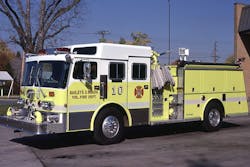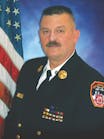Fifty years ago, no one in the fire service would have been able to predict the degree of engineering technology that has impacted the design of today’s fire apparatus. Electronic and safety components have been integrated into all sizes of apparatus, with touchscreens, wireless controls and envelope controls of aerial ladders, to name just a few examples. While some have been critical with respect to the lack of apparatus innovations over the past 10 years, the impact of changes within the NFPA 1901 standard and EPA regulations on diesel engine emissions have had a greater influence on vehicle design than any period in recent history.
History tends to repeat itself. Consider the recent introduction of ultra-high pressure fog pump systems, small attack apparatus, and electronic pump panels. These concepts were tried years ago and are now coming back in vogue. Some of these concepts have been marketed as innovations to improve firefighter safety, others as deployment options due to reductions in staffing levels. Apparatus manufacturers have developed products to differentiate themselves from competitors using available technology and component enhancements. Go to any fire industry conference and note what manufacturers are touting as new equipment designs. Some of these are truly new and innovative, but others may be recycled concepts from the past. With all this in mind, let’s look critically at some of our past apparatus history and how apparatus design has changed over the years.
Innovations of the past
Dating back to 1960, most apparatus was powered by gasoline engines with dual ignition systems, open cabs were common, and a 1,000-gpm fire pump with twin booster reels was standard. When Mack Trucks first introduced a diesel engine in apparatus built for Bermuda, it took almost 10 years before most fire departments accepted this technology.
This era of apparatus design was dominated by American LaFrance, Mack and Seagrave, with other regional builders such as Crown, Hahn and Maxim Motors enjoying a loyal following with many departments. During this period, several manufacturers engineered and produced their own axles, engines, transmissions and even fire pumps. Product integration was a key factor in securing business with most builders offering one or two cab and body configurations with some degree of customization. Innovations that were introduced included the elevation platform, rear-mount aerial ladders and intra-cab fire pumps.
Due to the production capacity and engineering standards, it was difficult for the smaller, regional builders to financially compete with the major manufacturers at the bid table. Apparatus specifications were less than 30 pages long, and blueprints were hand-drawn on a drafting table. In order to be recognized and compete with the larger manufacturers, regional builders would develop new designs in the marketplace to attract new customers. One of the recognized industry innovators was Dick Young, who operated Young Fire Equipment Corporation in Lancaster, NY, from the early 1950s until economic conditions caused the company to close in 1991.
Innovations pioneered by Young include the Crusader chassis, which featured a low-profile, 94-inch-wide cab, top-mount pump panels with speed lay hosebeds that were common configurations on Ford C-model cabs, mid-engine rear-mount platforms and hydraulic valve controls for pumps. When interviewed in October 2015, Young was candid about his assessment of the current state of the apparatus industry. He noted that some of today’s apparatus “have no real identity to the vehicle and the marketplace appears to be satisfied with the current products.” Consider for a moment the typical custom chassis pumper equipped with a full height, rescue-style body with roll-up doors, and visually what differentiates one manufacturer from the other. Back in the day, each cab design was aesthetically unique and while primitive with respect to seating and instrumentation, it was easy to distinguish a Mack CF from a Seagrave or Peter Pirsch apparatus.
Today’s apparatus tends to be longer and taller, requiring a series of steps and handrails to access the top of the hosebed and body compartments. Young introduced the use of Morton Cass non-slip step surfaces in 1962 and provided this material on all step surfaces, and in later years produced a three boom articulating platform with a mid-engine chassis. This box frame concept required three years of engineering design and became the forerunner for the Crusader II mid-engine chassis that was designed with a pedestal-style fire pump with custom-built intake and discharge manifolds providing a four-inch intake and discharge on all four sides of the vehicle.
To address issues with rust and corrosion on steel bodies, Young developed a modular body built with composite material, protected wheel liners and wiring harness to reduce down time and production costs. Over the years, as bills of materials (detailed parts listing of all of the components) were developed to help determine final cost of the apparatus, the apparatus industry focused on controlling material costs and reducing production cycle times. The requirement for special options and vehicle customization will never go away; however, the cost to meet these needs can be controlled by engineering designs and 3D modeling.
Each year, the automotive industry unveils concept vehicles to demonstrate their design capabilities and introduce future innovations. The fire apparatus market, with annual vehicle acquisitions of around 4,000 units each year, cannot support having prototype apparatus designs. Innovative vehicle designs are often the result of a specific requirement that causes everyone to go back to the drawing board. Consider the development of aerial devices over the years where fire department requirements for higher vertical reach with increased tip loads have influenced aerial designs. Small attack apparatus lead to the term “mini pumpers” during the early 1970s and became commonplace in departments, partially as a result of the success with two-piece engine companies in Syracuse, NY. The use of mini pumpers and tower ladders, first developed by Mack Trucks in coordination with the FDNY, are examples of manufacturer product offerings being built and field-tested, resulting in further product improvements.
Design for the future
The adage states, “What is old is new again.” When working with your apparatus committee, take time to study your fire department’s history and determine the current and future needs of the response district. The apparatus that you design today must provide service to the community for the next 15 to 20 years and embrace available technologies while enhancing the safety for your members.
Years from now, when the definitive history of fire apparatus is written, there will be lively debate as to the most innovative period and type of vehicle that was produced. The history of the fire apparatus industry will influence these discussions with much to be gained from defining the mission of your next apparatus to ensure success in the purchasing process.






